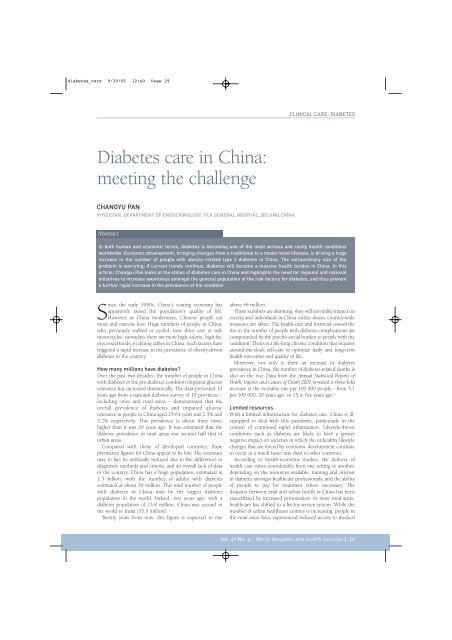World Hospitals and Health Services - International Hospital ...
World Hospitals and Health Services - International Hospital ...
World Hospitals and Health Services - International Hospital ...
Create successful ePaper yourself
Turn your PDF publications into a flip-book with our unique Google optimized e-Paper software.
diabetes_care 9/30/05 12:40 Page 29<br />
CLINICAL CARE: DIABETES<br />
Diabetes care in China:<br />
meeting the challenge<br />
CHANGYU PAN<br />
PHYSICIAN, DEPARTMENT OF ENDOCRINOLOGY, PLA GENERAL HOSPITAL, BEIJING,CHINA<br />
Abstract<br />
In both human <strong>and</strong> economic terms, diabetes is becoming one of the most serious <strong>and</strong> costly health conditions<br />
worldwide. Economic development, bringing changes from a traditional to a modernized lifestyle, is driving a huge<br />
increase in the number of people with obesity-related type 2 diabetes in China. The extraordinary size of the<br />
problem is worrying; if current trends continue, diabetes will become a massive health burden in China. In this<br />
article, Changyu Pan looks at the status of diabetes care in China <strong>and</strong> highlights the need for regional <strong>and</strong> national<br />
initiatives to increase awareness amongst the general population of the risk factors for diabetes, <strong>and</strong> thus prevent<br />
a further rapid increase in the prevalence of the condition<br />
Since the early 1990s, China’s soaring economy has<br />
apparently raised the population’s quality of life.<br />
However, as China modernizes, Chinese people eat<br />
more <strong>and</strong> exercise less. Huge numbers of people in China,<br />
who previously walked or cycled, now drive cars or ride<br />
motorcycles; nowadays there are more high-calorie, high-fat,<br />
processed foods on dining tables in China. Such factors have<br />
triggered a rapid increase in the prevalence of obesity-driven<br />
diabetes in the country.<br />
How many millions have diabetes?<br />
Over the past two decades, the number of people in China<br />
with diabetes or the pre-diabetes condition impaired glucose<br />
tolerance has increased dramatically. The data presented 10<br />
years ago from a national diabetes survey of 19 provinces –<br />
including cities <strong>and</strong> rural areas – demonstrated that the<br />
overall prevalence of diabetes <strong>and</strong> impaired glucose<br />
tolerance in people in China aged 25-64 years was 2.5% <strong>and</strong><br />
3.2% respectively. This prevalence is about three times<br />
higher than it was 20 years ago. It was estimated that the<br />
diabetes prevalence in rural areas was around half that of<br />
urban areas.<br />
Compared with those of developed countries, these<br />
prevalence figures for China appear to be low. The estimates<br />
may in fact be artificially reduced due to the differences in<br />
diagnostic methods <strong>and</strong> criteria, <strong>and</strong> an overall lack of data<br />
in the country. China has a huge population, estimated at<br />
1.3 billion, with the number of adults with diabetes<br />
estimated at about 30 million. This total number of people<br />
with diabetes in China may be the largest diabetes<br />
population in the world. Indeed, two years ago, with a<br />
diabetes population of 23.8 million, China was second in<br />
the world to India (35.5 million). 1<br />
Twenty years from now, this figure is expected to rise<br />
above 46 million. 1<br />
These numbers are alarming; they will inevitably impact on<br />
society <strong>and</strong> individuals in China unless drastic country-wide<br />
measures are taken. The health-care <strong>and</strong> financial costsof the<br />
rise in the number of people with diabetes complications are<br />
compounded by the psycho-social burden to people with the<br />
condition. Theirs is a life-long chronic condition that requires<br />
around-the-clock self-care to optimize daily <strong>and</strong> long-term<br />
health outcomes <strong>and</strong> quality of life.<br />
Moreover, not only is there an increase in diabetes<br />
prevalence in China, the number of diabetes-related deaths is<br />
also on the rise. Data from the Annual Statistical Reports of<br />
Death, Injuries <strong>and</strong> Causes of Death 2002 revealed a three-fold<br />
increase in the mortality rate per 100 000 people – from 5.1<br />
per 100 000, 20 years ago, to 15.4, five years ago. 2<br />
Limited resources<br />
With a limited infrastructure for diabetes care, China is illequipped<br />
to deal with this p<strong>and</strong>emic, particularly in the<br />
context of continued rapid urbanization. Lifestyle-driven<br />
conditions such as diabetes are likely to have a greater<br />
negative impact on societies in which the unhealthy lifestyle<br />
changes that are forced by economic development continue<br />
to occur at a much faster rate than in other countries.<br />
According to health-economic studies, the delivery of<br />
health care varies considerably from one setting to another,<br />
depending on the resources available, training <strong>and</strong> interest<br />
in diabetes amongst healthcare professionals, <strong>and</strong> the ability<br />
of people to pay for treatment where necessary. The<br />
disparity between rural <strong>and</strong> urban health in China has been<br />
exacerbated by increased privatization. In most rural areas,<br />
healthcare has shifted to a fee-for-service system. While the<br />
number of urban healthcare centres is increasing, people in<br />
the rural areas have experienced reduced access to medical<br />
Vol. 41 No. 3 | <strong>World</strong> <strong><strong>Hospital</strong>s</strong> <strong>and</strong> <strong>Health</strong> <strong>Services</strong> | 29

















